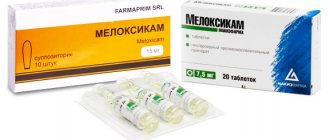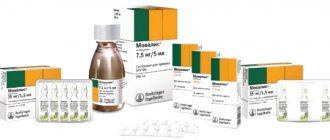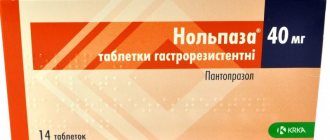Every person is familiar with the words: “Movement is life.” Indeed, an active lifestyle brings joy, but not to those who have problems with joints - for them, movement only brings pain and a bad mood. The musculoskeletal system wears out with age, hence the appearance of chronic joint pathologies - arthritis, arthrosis, osteochondrosis. To prevent the premature development of these diseases, you need to take preventive measures - do gymnastics for the joints, follow a diet. Sometimes it may be necessary to take special medications, which include, first of all, non-steroidal anti-inflammatory drugs, as well as medications for rheumatism. The first group is quite numerous. One of its representatives is Melbek, a medicine that has analgesic, anti-inflammatory, and antipyretic effects.
Pharmacological properties of the drug Melbek
Meloxicam, the active ingredient of Melbek, belongs to the oxicam group of NSAIDs, a selective COX-2 inhibitor, which contains enolic acid in its structure. The drug has a pronounced anti-inflammatory, analgesic and antipyretic effect. In studies, meloxicam exhibited high anti-inflammatory activity in all standard models of inflammation. The mechanism of action of the drug is the ability to inhibit the biosynthesis of prostaglandins - mediators of inflammation due to the selective inhibition of COX-2. The results of clinical studies have revealed significantly less toxicity of meloxicam compared to other drugs (for example, naproxen, piroxicam and diclofenac), which, by inhibiting COX-1 and COX-2 to the same extent, can damage the gastrointestinal tract and kidneys. A safer mechanism of action of meloxicam is associated with selective inhibition of COX-2 compared to COX-1. The IC50 selectivity coefficient of COX-1/COX-2 for meloxicam is 2, thanks to which the drug has the desired therapeutic effect and, compared with non-selective COX inhibitors, is less likely to cause adverse reactions from the gastrointestinal tract and kidneys. The selectivity of COX-2 inhibition by meloxicam has been confirmed by the results of many studies both in vitro and in vivo. Meloxicam does not affect platelet aggregation or bleeding time at recommended ex vivo , whereas indomethacin, diclofenac, ibuprofen and naproxen significantly inhibit platelet aggregation and prolong bleeding time. According to clinical studies, a low incidence of side effects from the digestive tract (perforation, ulceration and bleeding) has been established when using recommended doses of meloxicam compared to standard doses of other NSAIDs. Meloxicam is well absorbed from the gastrointestinal tract regardless of food intake. The bioavailability of the drug is 89%, the maximum concentration in the blood after oral administration is reached after 5–6 hours and, depending on the dose taken, is 0.4–1 mg/ml after taking 7.5 mg and 0.8–2.0 mg /ml after taking 15 mg of the drug. Equilibrium concentration is achieved on the 3rd–5th day of treatment. Meloxicam is completely absorbed after intramuscular injection, its bioavailability after parenteral administration is almost 100%. The pharmacokinetics of meloxicam is dose-dependent with intramuscular administration of 5 mg and 30 mg of the drug. The concentration of meloxicam in blood plasma reaches a maximum 60 minutes after intramuscular injection. Stable concentrations are achieved on days 3–5. About 99.5% of the drug binds to blood plasma proteins. The volume of distribution averages 11 liters. Meloxicam penetrates into the synovial fluid, where its concentration is approximately half lower than in blood plasma. Biotransformation occurs in the liver by oxidation of methyl groups to form four inactive metabolites. About 43% of the dose is excreted in the urine, the rest in bile. Less than 5% of the dose is excreted unchanged in the feces. The half-life of the drug is 20 hours. Hepatic and renal failure do not have a significant effect on the pharmacokinetics of meloxicam. Plasma clearance is 8 ml/min and decreases in the elderly. The volume of distribution is low, averaging 11 L. Individual deviations are 20–40% after IM application.
Use of the drug Melbek
The drug Melbek is prescribed to adults orally with a small amount of liquid once a day. For osteoarthritis - 7.5 mg per day, if necessary, the dose can be increased to 15 mg per day. For rheumatoid arthritis and ankylosing spondylitis : 15 mg 1 time per day, depending on the therapeutic effect, the dose can be reduced to 7.5 mg 1 time per day. Patients at high risk of side effects and patients on dialysis should begin treatment with a dose of 7.5 mg once daily. The maximum daily dose of meloxicam for adults is 15 mg. The duration of treatment is determined individually. It is advisable to prescribe IM use only during the first few days of treatment. To continue treatment, you need to use oral forms of the drug. The recommended dose is 7.5 or 15 mg per day, depending on the intensity of pain and severity of inflammation. Melbek should be used by deep intramuscular injection . Due to the possibility of incompatibility, Melbek injection solution cannot be mixed with other drugs in the same syringe. In patients with severe renal failure on dialysis, the dose should not exceed 7.5 mg per day. Melbek solution for injection should not be administered intravenously. Considering that the dosage regimen for children and adolescents under 15 years of age has not yet been established, the drug is recommended for the treatment only of adults and adolescents over 15 years of age. Combined use: the total daily dose of Melbek when used in the form of tablets or injection solution should not exceed 15 mg. The duration of treatment depends on the nature of the disease and the effectiveness of the therapy.
Composition and release form
The medicine Melbek is presented in the following forms:
- pills;
- solution (exclusively for intramuscular administration);
- rectal suppositories.
Melbek solution is packaged in 1.5 ml ampoules. It is distinguished by its greenish-yellow color. Each ampoule contains:
- active ingredient – meloxicam in the amount of 15 milligrams;
- additional substances - sodium hydroxide or hydrochloric acid solution, glycine, sodium chloride, amino sugar meglumine, Pluronic, glycofurol and injection liquid.
Side effects of the drug Melbek
Gastrointestinal:
- dyspepsia, nausea, vomiting, abdominal pain, constipation, diarrhea, flatulence;
- passing disturbances in biochemical indicators of liver function (for example, increased transaminases or bilirubin), belching, esophagitis, gastroduodenal ulcer;
- gastrointestinal perforation, colitis, hepatitis, gastritis.
Hematological:
- anemia;
- changes in the blood count, including the ratio of leukocytes, leukopenia and thrombocytopenia. Concomitant use of a potentially myelotoxic drug, especially methotrexate, can lead to the development of cytopenia.
Dermatological: itching, skin irritation, stomatitis, urticaria. Central nervous system disorders: dizziness, headache, tinnitus, lethargy, mood changes. Cardiovascular: edema, increased blood pressure, hot flashes, palpitations. Genitourinary: changes in renal function indicators (increased creatinine and/or urea in the blood serum), acute renal failure. Visual impairment: conjunctivitis, visual impairment. Hypersensitivity reactions: angioedema and hypersensitivity reactions.
Overdose
In case of an overdose of meloxicam, the following manifestations are possible: lethargy, drowsiness , lethargy , nausea, epigastric pain , vomiting, gastrointestinal bleeding , as well as anaphylactoid reactions .
In case of severe intoxication , the following were observed: acute kidney failure , increased blood pressure , impaired liver function , respiratory depression, convulsions , coma , cardiac arrest and vascular collapse .
Symptomatic and supportive therapy is prescribed using forced diuresis , urine alkalization, hemoperfusion or hemodialysis , which are not effective enough due to the high degree of binding of meloxicam to plasma proteins.
Special instructions for the use of the drug Melbek
It is necessary to strictly monitor the use of the drug in patients with a history of asthma. The drug is prescribed with caution to weakened patients, the elderly, patients with heart failure, as well as those taking anticoagulant and antiplatelet drugs. Patients with gastrointestinal pathology should be under close medical supervision. As with other NSAIDs, potentially fatal gastrointestinal complications (gastrointestinal bleeding, ulceration, or perforation) may occur at any time during treatment, with or without a history of serious gastrointestinal disease. Therefore, the use of Melbek is contraindicated for this category of patients. The most serious effects were observed in older people. NSAIDs inhibit the synthesis of renal prostaglandin, which plays an important role in maintaining renal blood flow. In patients with reduced renal blood flow, the use of NSAIDs may cause renal failure, which disappears after discontinuation of the drug. In patients with mild or moderately severe renal impairment (creatinine clearance ≤25 ml/min), the dose of the drug may not be reduced, but renal function should be carefully monitored. In some rare cases, NSAIDs can lead to the development of interstitial nephritis, glomerulonephritis, renal medullary necrosis or the development of nephrotic syndrome. Patients with chronic renal failure, after extensive surgery (which caused hypovolemia), as well as patients with cirrhosis of the liver are prone to such complications. In this case, monitoring of diuresis and renal function is necessary from the very beginning of therapy. NSAIDs can increase the retention of sodium, potassium and water in the body and affect the natriuretic effect of diuretics. As a consequence, heart failure or hypertension may develop or worsen in predisposed patients. If adverse reactions occur, you should stop taking the drug and consult a doctor. Meloxicam, like any other NSAID, can mask the symptoms of an underlying infectious disease. Pregnancy and lactation: despite the fact that no teratogenic effect was identified during preclinical studies, Melbek should not be used during pregnancy and lactation. There is no data regarding the effect of the drug on the ability to drive a car or operate automatic devices. However, if side effects from the central nervous system develop, it is recommended to refrain from such activities.
Contraindications
- heart failure ;
- hypersensitivity to meloxicam or minor ingredients of the drug;
- mention of bronchial asthma , conjunctivitis , nasal polyposis angioedema or skin rashes NSAIDs ;
- phase of exacerbation of gastrointestinal ulcer;
- hemorrhagic pathologies ( gastrointestinal bleeding , cerebrovascular bleeding , etc.);
- pain syndrome that developed after the coronary artery bypass ;
- breast-feeding;
- phase of exacerbation of inflammatory bowel diseases ( nonspecific ulcerative colitis , Crohn's disease , etc.);
- pregnancy;
- severe renal and/or hepatic pathologies;
- age up to 15 years.
Interactions of the drug Melbek
The simultaneous use of two or more NSAIDs (including salicylates) may increase the ulcerogenic risk and the likelihood of gastrointestinal bleeding due to the synergistic effect of the drugs. Lithium : combined use with lithium salts is not recommended, given the decrease in lithium excretion by the kidneys under the influence of NSAIDs, which may cause the accumulation of lithium and the manifestation of its toxic effect. Methotrexate : like other NSAIDs, Melbek can increase the toxic effect of methotrexate on the hematopoietic system, which requires monitoring of hemogram parameters over time. Meloxicam may enhance the effect of ticlopidine and heparin, which increases the risk of gastrointestinal bleeding. Contraception: In women using an intrauterine device, Melbek may reduce its contraceptive effect. Diuretics: Treatment of patients with symptoms of hypovolemia with NSAIDs is associated with a potential risk of acute renal failure. Therefore, before starting treatment, it is necessary to determine renal function, and in the future, in the case of simultaneous use of Melbek and diuretic drugs, patients should receive a sufficient amount of fluid. Antihypertensive drugs: Melbek may reduce the effectiveness of antihypertensive drugs (beta-adrenergic blockers, ACE inhibitors). NSAIDs and angiotensin II receptor antagonists and ACE inhibitors have a synergistic effect in reducing glomerular filtration. In patients with a history of renal impairment, this may lead to the development of acute renal failure. Cholestyramine binds meloxicam in the gastrointestinal tract, which accelerates the elimination of meloxicam. It is not recommended to use the drug simultaneously with cyclosporine , since the risk of the nephrotoxic effect of the latter increases. There may be a pharmacokinetic interaction between meloxicam and other drugs at the metabolic stage due to their effect on CYP 2C9 and/or CYP 3A4, which should be taken into account when using meloxicam and drugs that tend to inhibit or are metabolized by CYP 2C9 and/or CYP 3A4. . With simultaneous use, no pharmacokinetic interaction of the drug with antacids, digoxin and furosemide was detected. Interactions between the drug and oral antidiabetic agents cannot be excluded.







